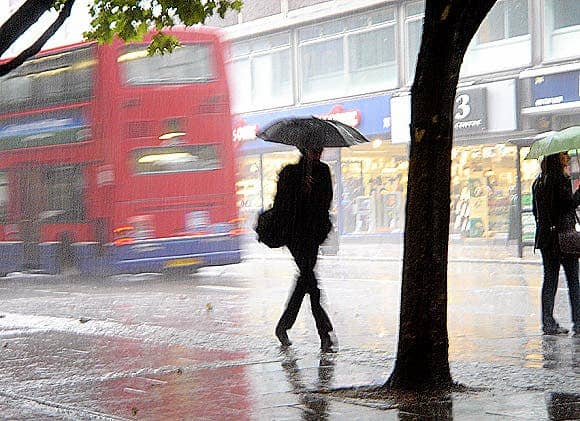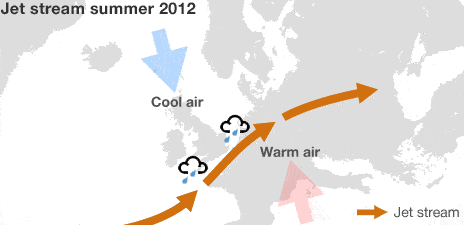
Before I first set foot in London, I – like most people – was under the impression that hellish gusts of wind and rain would be the most memorable parts of my trip. In reality, even though I visited in January, there were only a couple of days of rain, and even these quite mild. So I decided to investigate a bit.
What I found was that London isn’t by far the rainiest city out there, and moreover, because it rains time and time again this makes England considerably warmer than it should have been. Where does it all come from? If you ask me, it has something to do with the British love-hate relationship with rain: they say the weather’s dreadful, but they never seem to talk about anything else. In fact, I think it’s their best ice breaker during conversations. Secretly inside, every Brit adores the rain and I’m certain they couldn’t live without it – not without a short burst from time to time, at least.
The myth of a rainy London
Yet, even so, it doesn’t rain that much in London. Granted, the rest of Britain is one different matter altogether, especially the Highlands, but we’ll get to that soon enough. According to the Met Office Climate data, over the 30 year period, there were 106.5 days of rainfall per year on average (which counts as a day in which 1mm of rainfall or over fell). This means that there was rainfall on 29 per cent of days per year and on average it didn’t rain 71 per cent of days per year. Average rainfall is 557.4mm with 1410 “sunshine hours.”
There are more rainy days in Miami (at 135) and Orlando, Florida (117) than there are in London. New York City clocks in at 122 days and 1,268mm of rain. Washington DC, Rio de Janeiro, Sydney, and Mexico City all have more rainy days on average in any given year than London.
In the rest of the country, according to the UK Met Office, the average rainfall in Britain is 1,154mm per year. On average it rains for 156.2 days per year (data from 1981 to 2010). However, some parts of England are much wetter than others, and the farther west you go the likelier it is you’ll need to pack the iconic umbrella. The Scottish western Highlands get doused annually with over three meters of rain, the Lake District and the Pennines in the northwest of England top the rainy charts too, as well as the mountainous Snowdonia area in Wales and the higher ground of the Cornish and Devonshire moors. The map below released by the Met Office is quite revealing.

Why it rains so much in Britain
Granted, it does rain rather frequently in Britain, despite the exaggerated rumors. This mostly due to the island-state’s unfortunate location, being right in the path of the atmospheric jet stream. The jet stream, a massive but mysterious driver for British weather, usually passes along a steady path from West to East across the Atlantic – sometimes a bit to the North of us, sometimes a bit to the South. The flow of these streams is not a neat curve but a series of massive meanders. Britain is right on the northern side of those meanders where conditions are cooler and wetter which means which means the country keeps getting hit by rain.
Normally, we would expect the pattern of the jet stream to keep shifting, for its shape to switch every few days and for our weather to change as a result. Instead for week after week – and possibly for weeks ahead too – the meanders of the stream are sticking to the same shape so repeated rainstorms have become the norm. Nobody knows why this pattern is so static.

On top of this, there is the related question of climate change. Most researchers are extremely reluctant to attribute any single weather event to global warming. But Dr Peter Stott, a leading climate scientist at the UK Met Office, says that since the 1970s the amount of moisture in the atmosphere over the oceans has risen by 4%, a potentially important factor.
It’s worth mentioning that 2012 was an unusually rainy year having seen the”most exceptional period of rainfall in 248 years”. The report released by the Met Office reveals that while downpours and storms have not been out of the ordinary, their frequency has been.
“Each one of these individual events has not been particular outstanding, they’ve been broadly along the lines of what we would expect for a typical winter storm in the UK,” said Simon Parry from the CEH and co-author of the report. “What’s been notable about it, and different from what we’ve seen in the past, is the persistence.”
Two key factors the authors believe have contributed to the effect: a persistent high-pressure system lurking over a patch of the Pacific Ocean, off the west coast of North America and, second, the quasi-biennial oscillation (QBO).
So there you have it. The British do have their fair share of rain, the west more than the east, higher ground more than the low-lying areas, but feel no pity because the British love the rain. Without it, there’d be less to moan about and fewer occasions to perfect their famous stiff upper lip.


